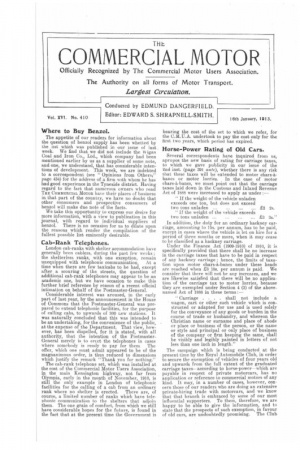Horse-Power Rating of Old Cars.
Page 1

Page 2

If you've noticed an error in this article please click here to report it so we can fix it.
Several correspondents have inquired from us, apropos the new basis of rating for carriage taxes, to which we gave publicity in our issue of the 2nd inst. (page 391 ante), whether there is any risk that these taxes will be extended to motor chars-abanes or motor lorries. In the case of motor chars-a-banes, we must point out that the carriage taxes laid down in the Customs and Inland Revenue Act of 1888 were increased to apply as under :— " If the weight of the vehicle unladen exceeds one ton, but does not exceed two tons unladen ... ... 22 2s. "11 the weight of the vehicle exceeds two tons unladen ... ... 23 3s."
In addition, the duty for an ordinary hackney carriage, amounting to 15s. per annum, has to be paid, except in cases where the vehicle is let on hire for a period of three months or more, when it may cease to be classified as a hackney carriage.
Under the Finance Act (1909-1910) of 1910, it is specifically provided that there shall be no increase in the carriage taxes that have to be paid in respect of any hackney carriage ; hence, the limits of taxation upon motor chars-a-bancs under these heads are reached when 13 18s. per annum is paid. We consider that there will not be any increases, and we are likewise satisfied that there will be no application of the carriage tax to motor lorries, because they are exempted under Section 4 (3) of the abovenamed Act of 1888 in these terms Carriage . . . . shall not include a wagon, cart or other such vehicle which is constructed or adapted for use and is used solely for the conveyance of any goods or burden in the course of trade or husbandry, and whereon the Christian name or surname and place of abode or place or business of the person, or the name or style and principal or only place of business of the company or firm keeping the same, shall be visibly and legibly painted in letters of not less than one inch in length."
The campaign which is being conducted at the present time by the Royal Automobile Club, in order to secure the exemption of vehicles of four years old and upwards from the full extent of the graduated carriage taxes—according to horse-power--which are payable in respect of private motorcars, has no application or reference to commercial motors of any kind. It may, in a number of cases, however, concern those of our readers who are doing an extensive private-hiring trade with motorcars, and we know that that branch is embraced by some of our most influential supporters. To them, therefore, we are happy to be able to give the information, and to state that the prospects of such exemption, in favour of old cars, are undoubtedly promising. The Club is acting in conjunction with the Automobile Association, the Commercial Motor Users Association, the Institution of Automobile Engineers, and the Society of Motor Manufacturers and Traders. Its argu.. ments, for presentation to the Chancellor of the Exchequer, are briefly these :—(a) the old car is of less value to the owner ; (b) it accomplishes less mileage, and is usually used for local and not for general touring purposes; (c) it is wasteful in petrol, and therefore pays additional tax in that way ; (d) many old cars at present unused would be brought into use.






















